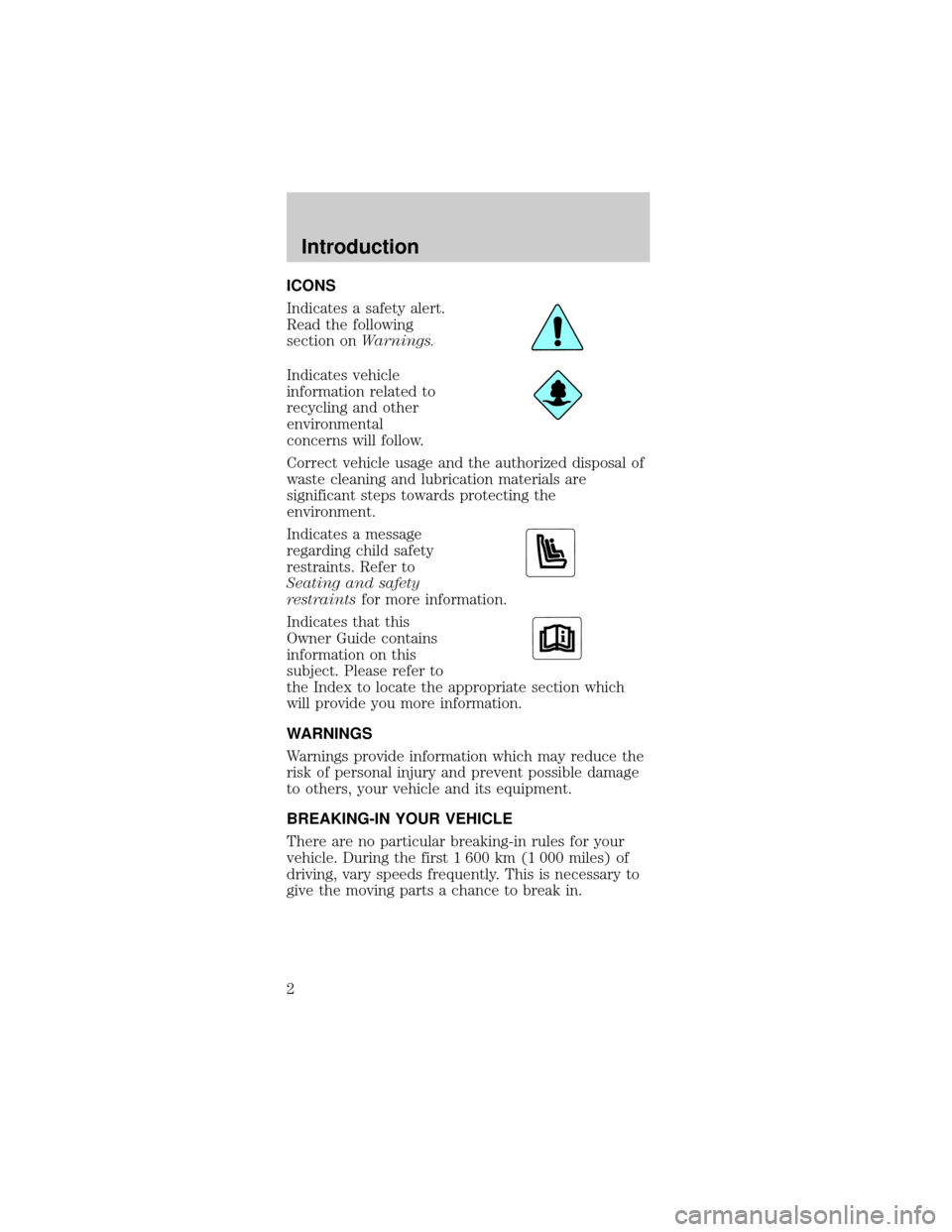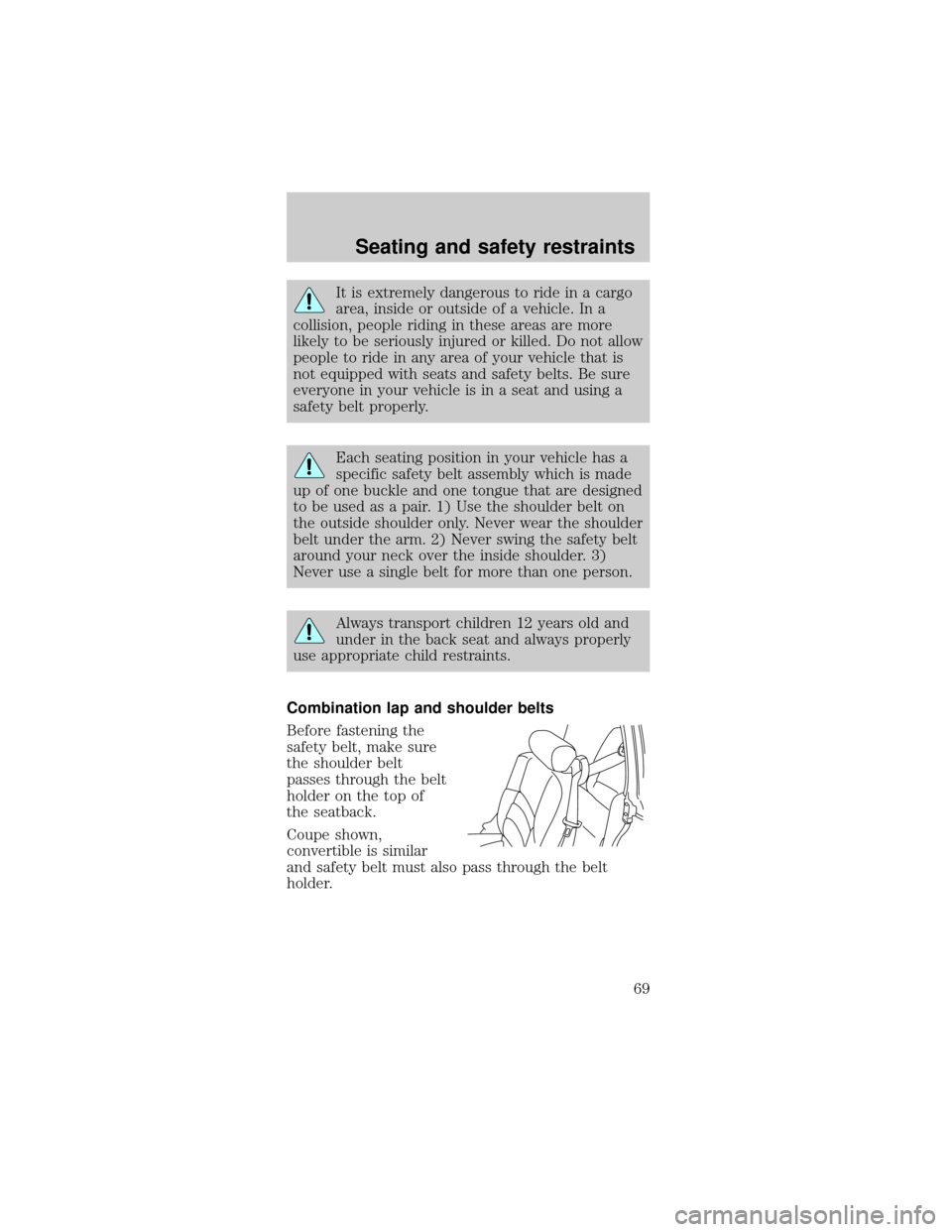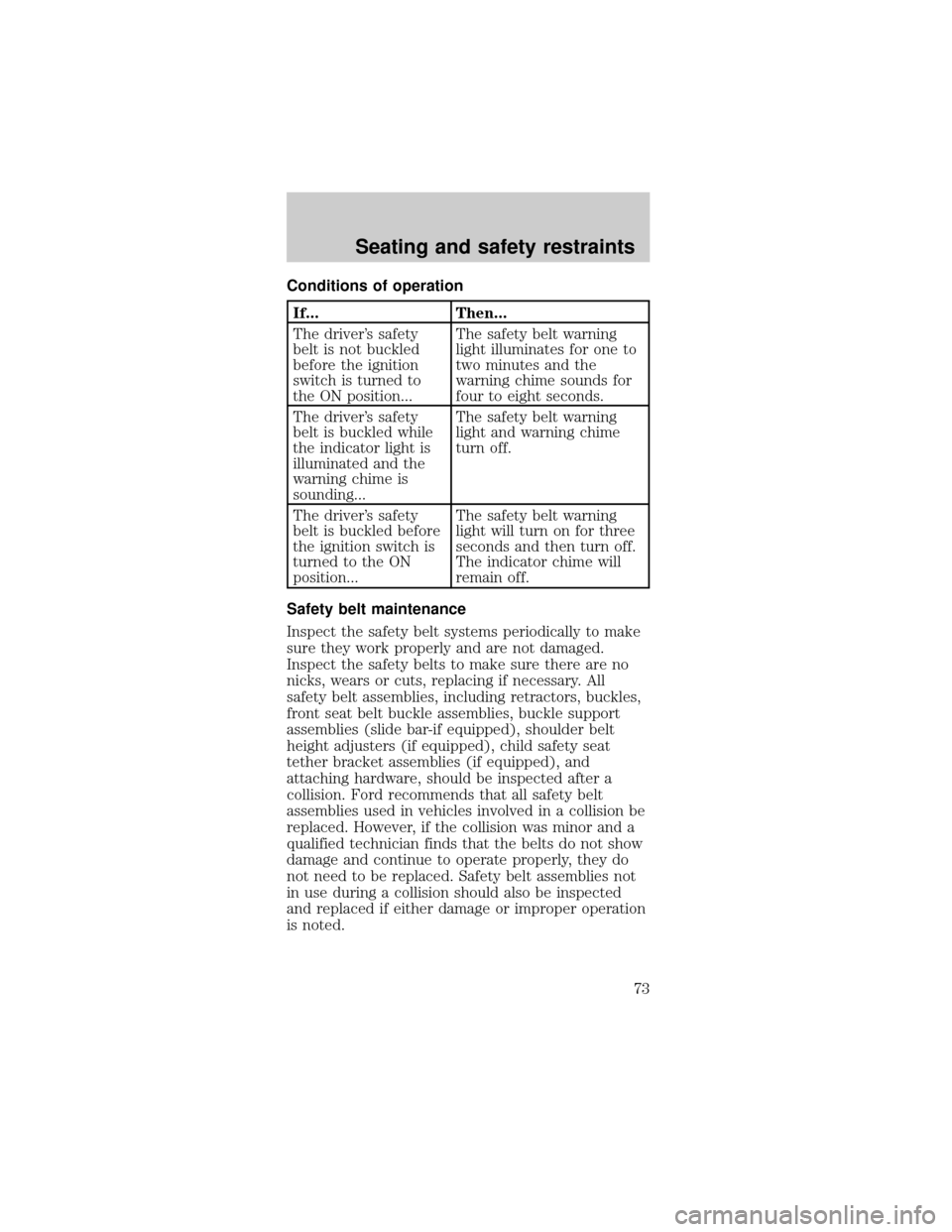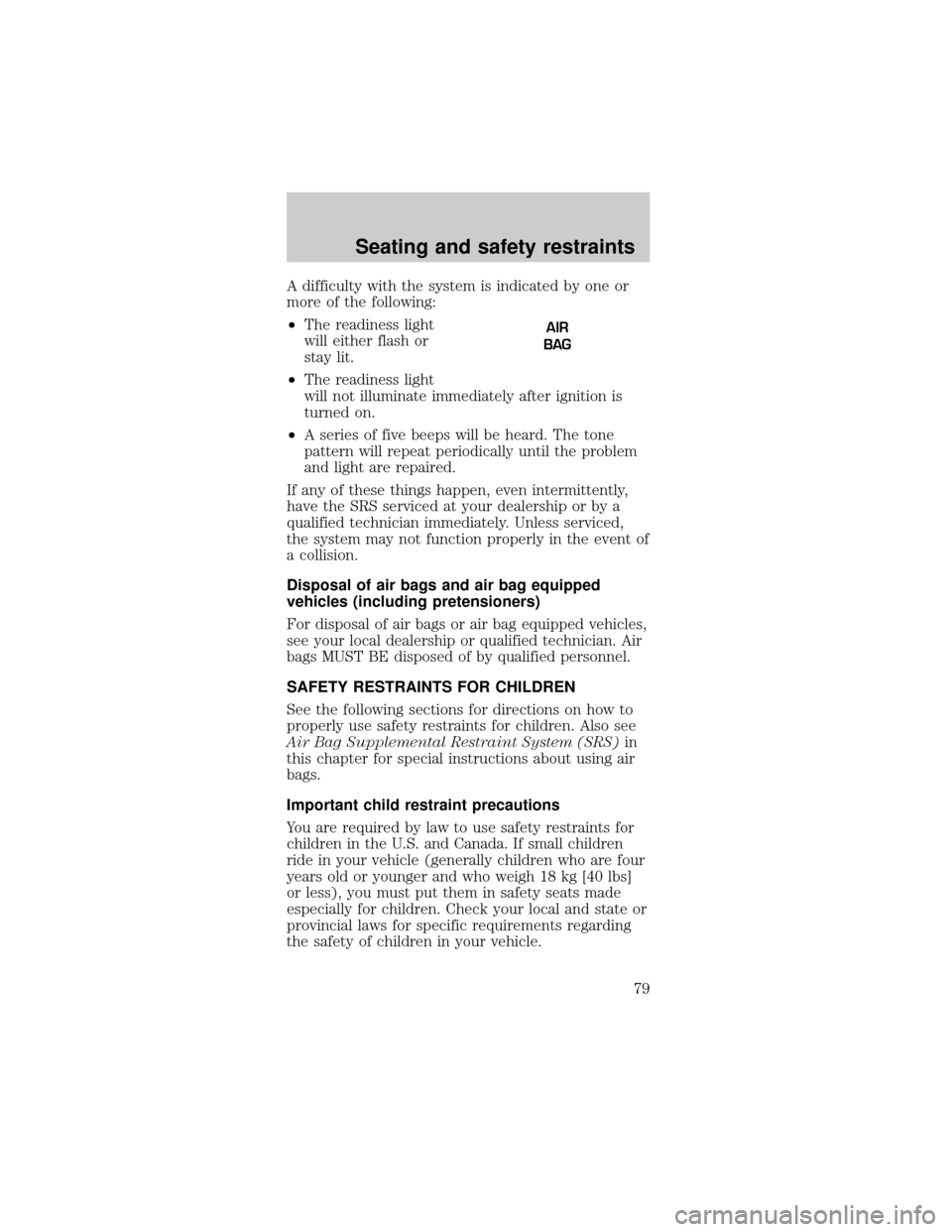Page 2 of 216

ICONS
Indicates a safety alert.
Read the following
section onWarnings.
Indicates vehicle
information related to
recycling and other
environmental
concerns will follow.
Correct vehicle usage and the authorized disposal of
waste cleaning and lubrication materials are
significant steps towards protecting the
environment.
Indicates a message
regarding child safety
restraints. Refer to
Seating and safety
restraintsfor more information.
Indicates that this
Owner Guide contains
information on this
subject. Please refer to
the Index to locate the appropriate section which
will provide you more information.
WARNINGS
Warnings provide information which may reduce the
risk of personal injury and prevent possible damage
to others, your vehicle and its equipment.
BREAKING-IN YOUR VEHICLE
There are no particular breaking-in rules for your
vehicle. During the first 1 600 km (1 000 miles) of
driving, vary speeds frequently. This is necessary to
give the moving parts a chance to break in.
Introduction
2
Page 68 of 216
2nd seat/Split-folding rear seat (if equipped)
One or both rear seatbacks can be folded down to
provide additional cargo space.
To lower the
seatback(s) from inside
the vehicle, pull tab to
release seat back and
then fold seatback
down.
When raising the seatback(s), make sure you hear
the seat latch into place.
SAFETY RESTRAINTS
Safety restraints precautions
Always drive and ride with your seatback
upright and the lap belt snug and low across
the hips.
To reduce the risk of injury, make sure
children sit where they can be properly
restrained.
Never let a passenger hold a child on his or
her lap while the vehicle is moving. The
passenger cannot protect the child from injury in a
collision.
All occupants of the vehicle, including the
driver, should always properly wear their
safety belts, even when an air bag SRS is provided.
Seating and safety restraints
68
Page 69 of 216

It is extremely dangerous to ride in a cargo
area, inside or outside of a vehicle. In a
collision, people riding in these areas are more
likely to be seriously injured or killed. Do not allow
people to ride in any area of your vehicle that is
not equipped with seats and safety belts. Be sure
everyone in your vehicle is in a seat and using a
safety belt properly.
Each seating position in your vehicle has a
specific safety belt assembly which is made
up of one buckle and one tongue that are designed
to be used as a pair. 1) Use the shoulder belt on
the outside shoulder only. Never wear the shoulder
belt under the arm. 2) Never swing the safety belt
around your neck over the inside shoulder. 3)
Never use a single belt for more than one person.
Always transport children 12 years old and
under in the back seat and always properly
use appropriate child restraints.
Combination lap and shoulder belts
Before fastening the
safety belt, make sure
the shoulder belt
passes through the belt
holder on the top of
the seatback.
Coupe shown,
convertible is similar
and safety belt must also pass through the belt
holder.
Seating and safety restraints
69
Page 71 of 216
The automatic locking mode is not available on the
driver safety belt.
When to use the automatic locking mode
²When a tight lap/shoulder fit is desired.
²Anytimea child safety seat is installed in a
passenger front or outboard rear seating position
(if equipped). Refer toSafety Restraints for
ChildrenorSafety Seats for Childrenlater in
this chapter.
How to use the automatic locking mode
²Buckle the
combination lap and
shoulder belt.
²Grasp the shoulder
portion and pull
downward until the
entire belt is
extracted.
Seating and safety restraints
71
Page 73 of 216

Conditions of operation
If... Then...
The driver's safety
belt is not buckled
before the ignition
switch is turned to
the ON position...The safety belt warning
light illuminates for one to
two minutes and the
warning chime sounds for
four to eight seconds.
The driver's safety
belt is buckled while
the indicator light is
illuminated and the
warning chime is
sounding...The safety belt warning
light and warning chime
turn off.
The driver's safety
belt is buckled before
the ignition switch is
turned to the ON
position...The safety belt warning
light will turn on for three
seconds and then turn off.
The indicator chime will
remain off.
Safety belt maintenance
Inspect the safety belt systems periodically to make
sure they work properly and are not damaged.
Inspect the safety belts to make sure there are no
nicks, wears or cuts, replacing if necessary. All
safety belt assemblies, including retractors, buckles,
front seat belt buckle assemblies, buckle support
assemblies (slide bar-if equipped), shoulder belt
height adjusters (if equipped), child safety seat
tether bracket assemblies (if equipped), and
attaching hardware, should be inspected after a
collision. Ford recommends that all safety belt
assemblies used in vehicles involved in a collision be
replaced. However, if the collision was minor and a
qualified technician finds that the belts do not show
damage and continue to operate properly, they do
not need to be replaced. Safety belt assemblies not
in use during a collision should also be inspected
and replaced if either damage or improper operation
is noted.
Seating and safety restraints
73
Page 75 of 216

All occupants of the vehicle, including the
driver, should always properly wear their
safety belts, even when an air bag SRS is provided.
Always transport children 12 years old and
under in the back seat and always properly
use appropriate child restraints.
National Highway Traffic Safety
Administration (NHTSA) recommends a
minimum distance of at least 25 cm (ten [10]
inches) between an occupant's chest and the
driver air bag module.
Never place your arm over the air bag
module as a deploying air bag can result in
serious arm fractures or other injuries.
Steps you can take to properly position yourself
away from the airbag:
²Move your seat to the rear as far as you can while
still reaching the pedals comfortably.
²Recline the seat slightly (one or two degrees)
from the upright position.
Do not put anything on or over the air bag
module. Placing objects on or over the air
bag inflation area may cause those objects to be
propelled by the air bag into your face and torso
causing serious injury.
Seating and safety restraints
75
Page 76 of 216
Do not attempt to service, repair, or modify
the Air Bag Supplemental Restraint System
or its fuses. See your Ford or Lincoln-Mercury
dealer.
Children and air bags
For additional
important safety
information, read all
information on safety
restraints in this guide.
Children must always
be properly restrained.
Accident statistics
suggest that children
are safer when
properly restrained in
the rear seating
positions than in the front seating position. Failure
to follow these instructions may increase the risk of
injury in a collision.
Air bags can kill or injure a child in a child
seat.NEVERplace a rear-facing child seat
in front of an active air bag. If you must use a
forward-facing child seat in the front seat, move
the seat all the way back.
Seating and safety restraints
76
Page 79 of 216

A difficulty with the system is indicated by one or
more of the following:
²The readiness light
will either flash or
stay lit.
²The readiness light
will not illuminate immediately after ignition is
turned on.
²A series of five beeps will be heard. The tone
pattern will repeat periodically until the problem
and light are repaired.
If any of these things happen, even intermittently,
have the SRS serviced at your dealership or by a
qualified technician immediately. Unless serviced,
the system may not function properly in the event of
a collision.
Disposal of air bags and air bag equipped
vehicles (including pretensioners)
For disposal of air bags or air bag equipped vehicles,
see your local dealership or qualified technician. Air
bags MUST BE disposed of by qualified personnel.
SAFETY RESTRAINTS FOR CHILDREN
See the following sections for directions on how to
properly use safety restraints for children. Also see
Air Bag Supplemental Restraint System (SRS)in
this chapter for special instructions about using air
bags.
Important child restraint precautions
You are required by law to use safety restraints for
children in the U.S. and Canada. If small children
ride in your vehicle (generally children who are four
years old or younger and who weigh 18 kg [40 lbs]
or less), you must put them in safety seats made
especially for children. Check your local and state or
provincial laws for specific requirements regarding
the safety of children in your vehicle.
AIR
BAG
Seating and safety restraints
79